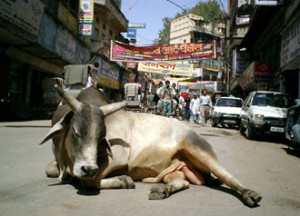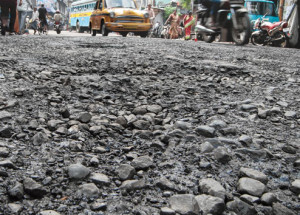One of the biggest differences between Christians and Hindus is the way they get married. Christian weddings represent the joining of two people in holy matrimony. Indian weddings represent the joining of not only two people, but two families. Most Christian weddings only take a day to complete, whereas the majority of Hindu weddings take four to seven days to complete as each event occurs on an individual day, with the exception of the wedding and the reception. .
To begin the preparations for an Indian wedding, the couple first gets engaged. If this wedding is an arranged marriage, where the parents of a person choose their spouse, then this will be the first time they see each other. The engagement ceremony is performed months before the actual wedding, and marks the start of the wedding celebration. Both families are present for this ceremony, which entails a ring exchange, and then a round of gifts for the happy couple. Then the ceremony is followed by a meal, in which the couple is celebrated. Another ceremony that occurs at some engagements is a sagai (read: Sah-gai), where the mother of the groom gives the bride gifts, such as jewelry, and clothing; and the bride’s family gives the groom a tilak (read tee-lak), a mark to say that he will be accepted by the bride’s family, and other gifts.
The next ceremony that is done is the pithi (read: pit-thee) ceremony, and it occurs a few days before the wedding. This is an individual ceremony so the bride and groom are not together during this time. The yellow pithi paste is made from turmeric, chickpea flour, and rosewater; and is applied to the bride and groom by their family and friends. This paste is thought to even the skin tone naturally, so both participants can look their best for their wedding day.
On the night before the wedding, a mehndi (read meh-hen-dhi) party is held. The bride, along with women on her side of the family, party the night away, while having henna applied to their skin. There is usually food, drinks, music, and laughter during the whole night. The henna designs are drawn on the females by a professional henna artist, and symbolize many different ideas, such as happiness, love, offering, beauty, and more.
Now the actual wedding begins…
Typically, the groom will ride to the wedding on a white horse, or rather in today’s world a luxury car, with the rest of his family and friends dancing their way to the wedding beside him. One of the bride’s family members acts as a lookout, and alerts everyone when they see the groom coming. The two families meet and the groom makes his way to the wedding pandel (read pah-an-del), a canopied area where he waits for his bride. A short worship ceremony is done to the god Ganesha (read Gah-neh-sha) to remove obstacles from the marriage. Then the bride is carried in on a palanquin, which is carried by male members of her family. The groom has a sheet in front of him, so he can not see his bride, and the bride holds betel leafs in front of her, so she can not see him until they put the garlands on. They uncover each other, and the couple exchange garlands to signify that they accept one another. Then the father of the bride places her hand into the groom’s hand to give her away. The end of the bride’s sari (read sah-ree) and the groom’s scarf (a part of his overall outfit made of thin material) is tied together, to symbolize unity and the bond of marriage. Then the ritual begins, with the lighting of the sacred fire, as a symbol of a divine presence in the marriage, and the priest begins the last worship ceremony. The bride and groom walk around the fire at first, while thinking about the four main aspirations of life in the Hindu culture: Duty, Prosperity, Karma, and Salvation. When it comes time to do the vows, the priest reads off the vows as the bride and groom walk around the fire seven times to signify the seven vows, taken from http://www.culturalindia.net/weddings/wedding-traditions/seven-vows.html.
“1.) Groom: You will offer me food and be helpful in every way. I will cherish you and provide welfare and happiness for you and our children.
Bride: I am responsible for the home and all household responsibilities.
2.) Groom: Together we will protect our house and children.
Bride: I will be by your side as your courage and strength. I will rejoice in your happiness. In return, you will love me solely.
3.) Groom:May we grow wealthy and prosperous and strive for the education of our children. May our children live long.
Bride: I will love you solely for the rest of my life, as you are my husband. Every other man in my life will be secondary. I vow to remain chaste.
4.) Groom: You have brought sacredness into my life, and have completed me. May we be blessed with noble and obedient children.
Bride: I will shower you with joy, from head to toe. I will strive to please you in every way I can.
5.) Groom: You are my best friend, and staunchest well-wisher. You have come into my life, enriching it. God bless you.
Bride: I promise to love and cherish you for as long as I live. Your happiness is my happiness, and your sorrow is my sorrow. I will trust and honor you, and will strive to fulfill all your wishes.
6.) Groom: May you be filled with joy and peace.
Bride:I will always be by your side.
7.) Groom: We are now husband and wife, and are one. You are mine and I am yours for eternity.
Bride: As God is witness, I am now your wife. We will love, honor and cherish each other forever.”
Then the groom gifts the bride a wedding necklace, and applies sindoor (sin-dor) to the bride’s head to show that she is married. She applies this on to the crown of her forehead as a symbol she is married for the rest of her life. Then the bride and groom finally exchange wedding rings, and feed each other sweets.
Before the reception, the couple is blessed by the elders in their family, and well-wished by all. Finally the reception happens, and the wedding is celebrated all night, much like a Christian wedding reception.







